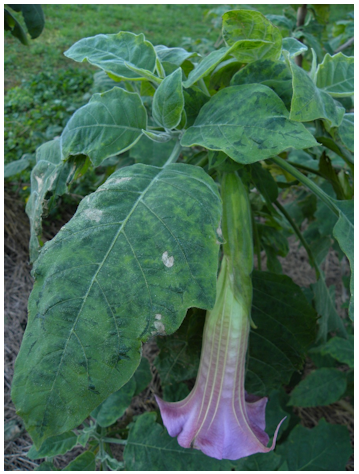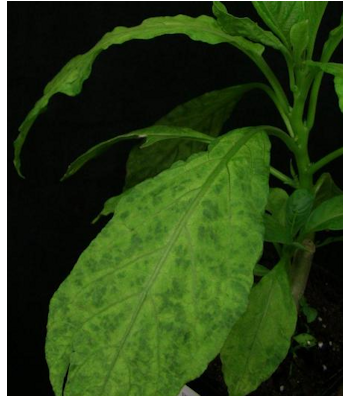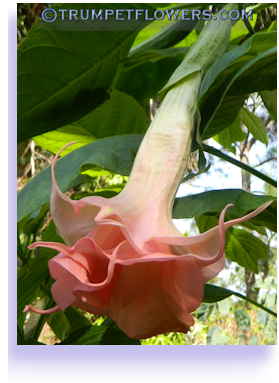 Columbian Datura Virus (CDV) is a virus that affects mainly cold group brugmansia, and datura. However, it has been found in isolated warm group brugmansia. Transmitted by aphids, this pest was first discovered in 1968 in Europe, and has since been reported in the Netherlands, Australia, Japan and recently, the United States. It weakens the plant's immmune system and in fruit crops like tomato, the plant has smaller fruits, and weak plant tissue. It is spead by aphids and broadmites, so controlling them is a good way to protect your brugmansia.
Columbian Datura Virus (CDV) is a virus that affects mainly cold group brugmansia, and datura. However, it has been found in isolated warm group brugmansia. Transmitted by aphids, this pest was first discovered in 1968 in Europe, and has since been reported in the Netherlands, Australia, Japan and recently, the United States. It weakens the plant's immmune system and in fruit crops like tomato, the plant has smaller fruits, and weak plant tissue. It is spead by aphids and broadmites, so controlling them is a good way to protect your brugmansia.
I must stress that this is highly contagious. Any Hybridizer or Nurseryman would destroy the plant(s) in question, burning all the material and soil, and start with a new, unaffected plant. This is a good practice, as it keeps it from spreading. Do your collection a favor and just get rid of it. The plant can be replaced. Replacing a collection is much harder.
Preventative measures include aphid control as your main means of defense. Read more here: Checkbiotech.org
You can also give the treatment Axiom a try at preventing CDV. It stimulates the plant's immune system, promote good growth and all around better health to the plant. It is also a more organic means of control, and less harmful to the environment than other toxic treatments available.
 Tobacco Mosaic Virus is something that all growers of brugmansia and datura should be aware of. It attacks the world's food crops, as well as the tobacco crops it was named after. To this day, there is no cure for it, but there are plenty of ways to prevent it from getting into your collection. The use of Actinovate is a very good start. Actinovate is a bacteria that is used as a soil drench, and after they set up camp in your potting mix they eat the fungus that can cause Tobacco Mosaic Virus, or TMV. It is a natural way to try and keep this dread disease from spreading to your collection.
Tobacco Mosaic Virus is something that all growers of brugmansia and datura should be aware of. It attacks the world's food crops, as well as the tobacco crops it was named after. To this day, there is no cure for it, but there are plenty of ways to prevent it from getting into your collection. The use of Actinovate is a very good start. Actinovate is a bacteria that is used as a soil drench, and after they set up camp in your potting mix they eat the fungus that can cause Tobacco Mosaic Virus, or TMV. It is a natural way to try and keep this dread disease from spreading to your collection.
TMV is so deadly to brugmansia because it weakens the plant's immune system. You will see bubbly leaves that have light and dark green marbling. The overall health of the plant is diminished, and it will continue to wane. If you think you may have this, the plant must be burned, along with the soil and the pot it was in. TMV can live in dead plant material, and in soil for up to 50 years. It just lies dormant waiting for it's next victim...a plant from the solanceae family, such as our beloved brugmansia.
Because it is a virus that affects some very important commercial crops, researchers are constantly working to cure this.Many cultivars of tomato seeds have this isolated, or removed, from their genes and are now resistant to TMV. But because brugmansia has no real commercial value, it has not been attempted in this species. However, if the research pays off, we may yet see a cure to this and not have to throw infected brugmansia plants on the burnpile. We shall see.
Last word on both of these problems is that sometimes, something that looks like either of the above is also just an anomly caused by stress, not properly feeding the plant, or something even caused by insect pests. The only way you can be sure your plant has these problems is through a microscopic test run on plant in question by your local Agricultural Extension Office. These tests are usually only around 20.00.
Learn more about protecting your plants from pathogens and other pests by reading Cycle Collection.
Tags: shrub, tree, fungal, diseases, fungal diseases, plant viral diseases, brugmansia,, shrub, tree, fungal, diseases, fungal diseases, cdv, tmv, tobacco mosaic virus, columbian datura virus, virus, angel trumpet, plant, tree, shrub, viral, actinovate, prevention,


